FISHER & PAYKEL DD24SHTI6, DD24SCHTX6, DD24SDFX6, DD24DHTI6, DD24DDFX6 User Manual
...
User guide
DishDrawer
DD24 models
Guide de l’utilisateur
DishDrawer®
Modèles de série DD24
US CA
Contents |
|
1 |
US CA |
|
|
||
Safety and warnings |
3 |
|
|
|
|
||
Operating instructions |
|
|
|
Controls (models with no LCD) |
6 |
|
|
Controls (models with LCD) |
8 |
|
|
Operation |
10 |
|
|
Wash program chart |
11 |
|
|
Caring for your dinnerware |
12 |
|
|
Dishwasher standards test |
13 |
|
|
Racking features |
14 |
|
|
Loading suggestions |
16 |
|
|
Detergent dispenser |
18 |
|
|
Water softener |
20 |
|
|
Rinse agent dispenser |
22 |
|
|
Option adjustments |
23 |
|
|
User maintenance instructions |
26 |
|
|
Troubleshooting |
29 |
|
|
Fault codes |
31 |
|
|
Warranty and service |
34 |
|
|
Important!
SAVE THESE INSTRUCTIONS
The models shown in this User Guide may not be available in all markets and are subject to change at any time. For current details about model and specification availability in your country, please visit our local website listed on the back cover or contact your local Fisher & Paykel dealer.

US CA

Safety and warnings 3 US CA
Your DishDrawer has been carefully designed to operate safely during normal dishwashing procedures. Please keep the following instructions in mind when you are using your DishDrawer®.
Important safety instructions
WARNING! - When using your dishwasher, follow basic precautions, including the following: Read all instructions before using the DishDrawer®.
The information in this manual must be followed to minimize the risk of fire or explosion or to prevent property damage, personal injury or loss of life.
Use the DishDrawer® only for its intended function as described in this user guide.
Use only detergents or rinse agent recommended for use in a domestic dishwasher and keep them out of reach of children. Check that the detergent dispenser is empty after the completion of each wash program.
When loading items to be washed, locate sharp items so that they are not likely to damage the lid seal and load sharp knives with the handle up to reduce the risk of cut-type injuries.
Do not touch the heater plate during or immediately after use.
Do not operate your DishDrawer® unless all enclosure panels are properly in place. Do not tamper with the controls.
Do not abuse, sit on, stand in or on the drawer or dish rack of the DishDrawer®.
The adjustable racks are designed to support cups, glasses and kitchen utensils. When the adjustable racks are in the DishDrawer® do not lean on or use them to support your body weight.
To reduce the risk of injury, do not allow children to play in or on the DishDrawer®.
Under certain conditions, hydrogen gas may be produced in a hot water heater system that has not been used for two weeks or more. HYDROGEN GAS IS EXPLOSIVE. If the hot water system has not been used for such a period, before using the dishwasher, turn on all hot water faucets and let the water flow from each for several minutes. This will release any accumulated hydrogen gas. As the gas is flammable, do not smoke or use an open flame during this time.
Remove the door to the washing compartment when removing an old dishwasher from service or discarding it.
Dishwasher detergents are alkaline. They can be dangerous if swallowed. Avoid contact with skin and eyes, keep children and infirm persons away from the dishwasher when the drawer is opened.

US CA 4 Safety and warnings
Important safety instructions
Installation
This DishDrawer® must be installed and located in accordance with the Installation instructions before it is used. If you did not receive Installation instruction sheets with your DishDrawer®, you can order them by calling your Authorized Service Agent or from the Fisher & Paykel website, www.fisherpaykel.com.
Installation and service must be performed by a qualified technician.
If the power supply cord is damaged, it must be replaced by a dealer or Authorized Service Center or a similar qualified trades person in order to avoid a hazard.
Ensure the DishDrawer® is secured to adjacent cabinetry using the brackets provided. Failure to do so may result in an unstable product, which may cause damage or injury.
Do not operate this appliance if it is damaged, malfunctioning, partially disassembled or has missing or broken parts, including a damaged power supply cord or plug.
Do not store or use petrol, or other flammable vapors and liquids in the vicinity of the DishDrawer®.
Connect to a properly rated, protected and sized power supply circuit to avoid electrical overload. Make sure that the power supply cord is located so that it will not be stepped on, tripped over or otherwise subject to damage or stress.
Do not install or store the DishDrawer® where it will be exposed to temperatures below freezing or exposed to weather.
Do not use an extension cord or a portable electrical outlet device (e.g. multi-socket outlet box) to connect the DishDrawer® to the power supply.
This appliance must be grounded. In the event of a malfunction or breakdown, grounding will reduce the risk of electric shock by providing a path of least resistance for electric current. This appliance is equipped with a cord having an equipment-grounding conductor and a grounding plug. The plug must be plugged into an appropriate outlet that is installed and grounded
in accordance with all local codes and ordinances. WARNING - Improper connection of the equipment-grounding conductor can result in a risk of electric shock. Check with a qualified electrician or service representative if you are in doubt as to whether the appliance is properly grounded. Do not modify the plug provided with the appliance; if it will not fit the outlet, have a proper outlet installed by a qualified technician.
If the DishDrawer® is installed as a permanently connected appliance:
GROUNDING INSTRUCTIONS - This appliance must be connected to a grounded metal, permanent wiring system, or an equipment-grounding conductor must be run with the circuit conductors and connected to the equipment-grounding terminal or lead on the appliance.

Safety and warnings 5 US CA
Important safety instructions
Maintenance
Do not repair or replace any part of the appliance or attempt any servicing unless specifically recommended in this user guide. We recommend that you call an Authorized Service Agent. Keep the floor around your appliance clean and dry to reduce the possibility of slipping. Keep the area around/underneath your appliance free from the accumulation of combustible materials, such as lint, paper, rags and chemicals.
When cleaning the underside of the filter plate, care must be taken on the sharp outer edge to avoid the risk of cut type injuries.
Important!
Under no circumstances should you open the drawer whilst the DishDrawer® is in operation.
Operational
Always press the  button to pause and wait until you hear the three additional beeps before opening the drawer.
button to pause and wait until you hear the three additional beeps before opening the drawer.
The DishDrawer® must be used with the motor assembly, filter plate, drain filter and spray arm in place.
When disconnecting the appliance pull the plug rather than the power supply cord or junction of cord to avoid damage.
Take care when loading the DishDrawer® not to load dishware items so they prevent the lid from properly sealing with the drawer. Items should be placed so they do not protrude above and/or forced into the drawer, otherwise a service call may result.
Household appliances are not intended to be played with by children. Children or persons with a disability which limits their ability to use the appliance, should have a responsible person instruct them in its use. The instructor should be satisfied that they can then use the appliance without danger to themselves or their surroundings.
Close supervision is necessary if this appliance is used by or near children. Do not allow children to play inside, on or with this appliance or any discarded appliance.
If a dishwasher cleaner is used, we would strongly recommend a wash program with detergent should be run immediately afterward, to prevent any damage to the DishDrawer®.
The DishDrawer® is designed for washing normal household utensils. Items that are contaminated by petrol, paint, steel or iron debris, corrosive, acidic or alkaline chemicals are not to be washed in the DishDrawer®.
If the DishDrawer® is not being used for long periods of time, turn the electricity and water supply to the DishDrawer® off.
Do not pour detergent or rinse agent into the salt reservoir. The detergent or rinse agent will destroy the water softener.

US CA 6 Operating instructions - Controls (models with no LCD)
If you have a double DishDrawer®, each drawer has its own controls and can run independently of the other.
Power button
The button turns the DishDrawer® on or off. Opening the drawer will automatically turn the DishDrawer® on for 30 seconds. To end a wash program in mid cycle, press the
button turns the DishDrawer® on or off. Opening the drawer will automatically turn the DishDrawer® on for 30 seconds. To end a wash program in mid cycle, press the button. Any water in the DishDrawer® will be pumped out.
button. Any water in the DishDrawer® will be pumped out.
Start/Pause button 
The  button starts a wash program. Press the
button starts a wash program. Press the  button to pause or restart the DishDrawer® during a wash program. When paused, wait for three beeps before opening the drawer. Forcing the drawer open while in mid cycle may cause damage or injury.
button to pause or restart the DishDrawer® during a wash program. When paused, wait for three beeps before opening the drawer. Forcing the drawer open while in mid cycle may cause damage or injury.
Delay start
The  button also sets the Delay start feature which can delay the start of a wash program from 1 to 12 hours.
button also sets the Delay start feature which can delay the start of a wash program from 1 to 12 hours.
To activate Delay start
1Press and hold the  button until the light above the
button until the light above the  button turns orange (or purple, depending on your model).
button turns orange (or purple, depending on your model).
2Continue holding the  button down until the desired delay time has been reached. The DishDrawer® will emit audible ‘beeps’ as you hold the
button down until the desired delay time has been reached. The DishDrawer® will emit audible ‘beeps’ as you hold the  button down, each beep indicates
button down, each beep indicates
another hour delay.
3The DishDrawer® will start once the delay time has elapsed and the drawer is closed.
To cancel Delay start
Press the button.
button.
Lock button  /
/ (optional)
(optional)
The |
/ |
button activates/deactivates the Keylock or the Childlock functions. |

Operating instructions - Controls (models with no LCD) 7 US CA
Keylock
The Keylock feature disables all the buttons on the DishDrawer®.
To activate, press and hold the /
/ button until you hear one beep (3 seconds). The light above the
button until you hear one beep (3 seconds). The light above the /
/ button is lit when Keylock is activated.
button is lit when Keylock is activated.
To cancel the Keylock feature, press and hold the /
/ button until the light above the
button until the light above the /
/ button disappears.
button disappears.
Childlock
The Childlock feature locks the drawer and disables all the buttons.
To activate, press and hold the /
/ button until you hear two beeps (5 seconds). The light above the
button until you hear two beeps (5 seconds). The light above the /
/ button is lit when Childlock is activated.
button is lit when Childlock is activated.
To cancel the Childlock feature, press and hold the /
/ button until the light above the /
button until the light above the /  button disappears.
button disappears.
Wash program selector
Press the  button to select a wash program. The DishDrawer® will remember the last program used.
button to select a wash program. The DishDrawer® will remember the last program used.
Eco button (optional)
(optional)
Press the button if you would like the wash program to use less energy. The red ECO light will indicate the feature is on. If your dishes are heavily soiled or you require enhanced dry performance, we do not recommend ECO programmes.
button if you would like the wash program to use less energy. The red ECO light will indicate the feature is on. If your dishes are heavily soiled or you require enhanced dry performance, we do not recommend ECO programmes.
Power failure
If the DishDrawer® is operating and a power failure occurs, it will stop. The DishDrawer® may be unable to be opened during this time. When the power supply is resumed, the DishDrawer® will restart in the same part of the wash program.
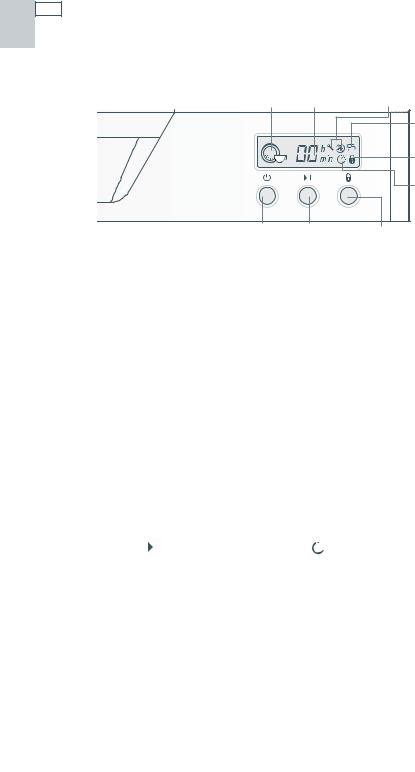
US CA 8 Operating instructions - Controls (models with LCD)
If you have a double DishDrawer®, each drawer has its own control panel and can run independently of the other.
Wash program |
Time |
Fault symbols - see ‘Fault |
progress symbol |
remaining |
codes’ if they appear |
Salt reservoir is empty |
(DD24-H models only) |
Keylock or Childlock is |
activated |
Delay start symbol |
Power |
Start/Pause Lock button |
button |
button |
Power button
The button turns the DishDrawer® on or off. Opening the drawer will automatically turn the DishDrawer® on for 30 seconds. To end a wash program in mid cycle, press the
button turns the DishDrawer® on or off. Opening the drawer will automatically turn the DishDrawer® on for 30 seconds. To end a wash program in mid cycle, press the button. Any water in the DishDrawer® will be pumped out.
button. Any water in the DishDrawer® will be pumped out.
Start/Pause button 
The  button starts a wash program. Press the
button starts a wash program. Press the  button to pause or restart the DishDrawer® during a wash program. When paused, wait for three beeps before opening the drawer. Forcing the drawer open while in mid cycle may cause damage or injury.
button to pause or restart the DishDrawer® during a wash program. When paused, wait for three beeps before opening the drawer. Forcing the drawer open while in mid cycle may cause damage or injury.
Delay start
The  button also sets the Delay start feature which can delay the start of a wash program from 1 to 12 hours.
button also sets the Delay start feature which can delay the start of a wash program from 1 to 12 hours.
To activate Delay start
1 Press and hold the  button until the delay symbol
button until the delay symbol 
 appears on the electronic display.
appears on the electronic display.
2Continue holding the  button down until the desired delay time has been reached.
button down until the desired delay time has been reached.
3The DishDrawer® will start once the delay time has elapsed and the drawer is closed.
To cancel Delay start
Press the button.
button.
Lock button  (optional)
(optional)
The  button activates/deactivates the Keylock or the Childlock functions.
button activates/deactivates the Keylock or the Childlock functions.
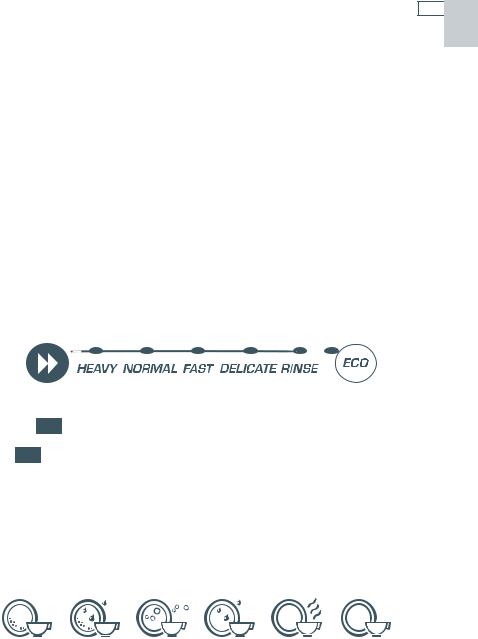
Operating instructions - Controls (models with LCD) 9 US CA
Keylock
The Keylock feature disables all the buttons on the control panel.
To activate, press and hold the  button until you hear one beep (3 seconds). The
button until you hear one beep (3 seconds). The  symbol appears in the electronic display when the Keylock feature is activated.
symbol appears in the electronic display when the Keylock feature is activated.
Childlock
The Childlock feature locks the drawer and disables all the buttons on the control panel.
To activate, press and hold the  button until you hear two beeps (5 seconds). The
button until you hear two beeps (5 seconds). The  symbol appears in the electronic display when the Childlock feature is activated.
symbol appears in the electronic display when the Childlock feature is activated.
To cancel the Childlock feature, press and hold the  button until you hear one beep and the
button until you hear one beep and the  symbol disappears from the electronic display.
symbol disappears from the electronic display.
Wash program selector
Press the  button to select a wash program. The DishDrawer® will remember the last program used.
button to select a wash program. The DishDrawer® will remember the last program used.
Eco button
 (optional)
(optional)
Press the
 button if you would like the wash program to use less energy. The red ECO light will indicate the feature is on. If your dishes are heavily soiled or you require enhanced dry performance, we do not recommend ECO programmes.
button if you would like the wash program to use less energy. The red ECO light will indicate the feature is on. If your dishes are heavily soiled or you require enhanced dry performance, we do not recommend ECO programmes.
Wash program progress symbols
As the wash program advances through the cycle, the following symbols will appear in the electronic display to indicate the progression. When a wash program has started, the electronic display also will count down the time remaining in one minute increments.
Dirty |
Pre Wash |
Main Wash |
Post Rinse |
Drying |
Clean |
Power failure
If the DishDrawer® is operating and a power failure occurs, it will stop. The DishDrawer® may be unable to be opened during this time. When the power supply is resumed, the DishDrawer® will restart in the same part of the wash program.
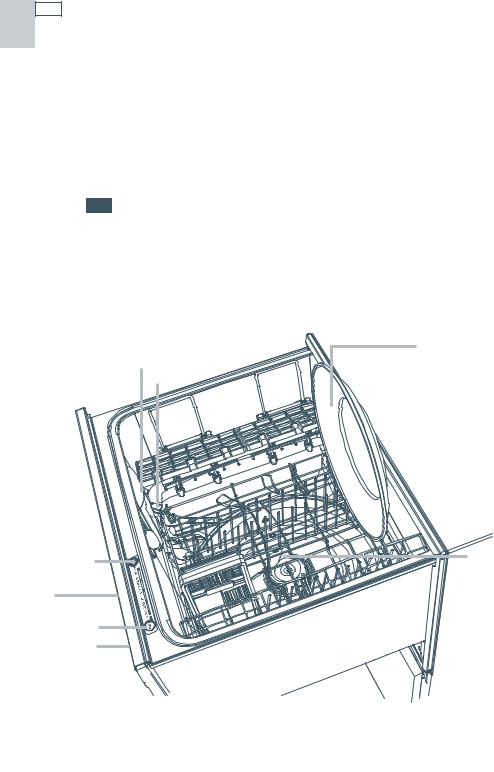
US CA 10 Operating instructions - Operation
1Load dishes
Remove all food scraps and load the dishes.
2Add detergent
3 Check rinse agent
4Press the button
button
5Select a wash program
The length of the wash program will appear on the electronic display (models with LCD only).
6 Select 
 (optional)
(optional)
7Check
Ensure there is nothing obstructing the spray arm. The drain filter must be level with the filter plate.
2
3
5
8
6
4
8Start
Close the drawer and press the  button.
button.
9Finish
The DishDrawer® will beep six times to indicate the end of the wash program. At the end of the wash program the drying fan will continue to run for a set time or until the drawer is opened. The fan assists with drying and uses negligible amounts of energy. It
is normal for some water to remain in the drain filter area after the wash program is complete.
Double models only: At the end of a wash program, you may find both drawers draining simultaneously. This is normal.
1
7
|
|
|
Wash program chart |
|
11 |
US CA |
|
|
|
|
|
|
|||
|
|
|
|
|
|
||
|
|
|
|
|
|
|
|
Standard wash program - when to use |
|
|
|
|
|
||
Heavy |
Normal |
Fast |
Delicate |
Rinse |
|
|
|
Heavily soiled |
Dishes with |
Lightly soiled |
Lightly soiled and |
Prevents odors and |
|
|
|
pots, pans and |
normal soils |
dishes. |
heat sensitive |
soils drying on dishes. |
|||
dishes. |
for optimum |
|
crockery. |
|
|
|
|
|
wash and dry |
|
|
|
|
|
|
|
performance. |
|
|
|
|
|
|
|
|
|
|
|
|
|
|
pre-wash 1 |
pre-wash 1 |
|
pre-wash |
pre-wash |
|
|
|
|
|
|
|
|
|
|
|
pre-wash 2 |
pre-wash 2 |
|
|
|
|
|
|
|
|
|
|
|
|
|
|
main wash 150oF |
main wash 140oF |
main wash 130oF |
main wash 120oF |
|
|
|
|
post-rinse 1 |
post-rinse |
post-rinse |
post-rinse |
|
|
|
|
|
|
|
|
|
|
|
|
post-rinse 2 |
|
|
|
|
|
|
|
|
|
|
|
|
|
|
|
final rinse 163oF |
final rinse 140oF |
final rinse 120oF |
final rinse 130oF |
|
|
|
|
drying phase |
drying phase |
|
drying phase |
|
|
|
|
|
|
|
|
|
|
||
|
|
|
|
|
|
||
Eco wash program - when to use |
|
|
|
|
|
||
Heavy |
Normal |
Fast |
Delicate |
|
|
|
|
Heavily soiled |
Normal soiled |
Lightly soiled, non |
Lightly soiled, |
|
|
|
|
everyday dishes. |
dishes for |
greasy dishes. |
non greasy and |
|
|
|
|
|
optimum energy |
|
heat sensitive |
|
|
|
|
|
use. |
|
crockery. |
|
|
|
|
|
|
|
|
|
|
|
|
pre-wash 1 |
pre-wash |
|
pre-wash |
|
|
|
|
|
|
|
|
|
|
|
|
pre-wash 2 |
|
|
|
|
|
|
|
|
|
|
|
|
|
|
|
main wash 150oF |
main wash 130oF |
main wash 115oF |
main wash 115oF |
|
|
|
|
post-rinse 1 |
post-rinse |
post-rinse |
post-rinse |
|
|
|
|
|
|
|
|
|
|
|
|
post-rinse 2 |
|
|
|
|
|
|
|
|
|
|
|
|
|
|
|
final rinse 150oF |
final rinse 130oF |
final rinse 115oF |
final rinse 120oF |
|
|
|
|
drying phase |
drying phase |
|
drying phase |
|
|
|
|
|
|
|
|
|
|
|
|
Note:
Wash times can vary depending on the incoming water temperature, ambient conditions, type of dish load and whether the drawer has been opened during the wash. Wash times are only APPROXIMATE on the electronic display and based on 120°F incoming water.

US CA 12 Caring for your dinnerware
The combination of high temperatures and dishwasher detergent may cause damage to some items if they are washed in the DishDrawer®. Remember, if in any doubt about any aspect concerning items washed in the DishDrawer®, follow the instructions from the manufacturer of the items, or wash the item by hand.
Cutlery & silverware
All cutlery and silverware should be rinsed immediately after use to prevent tarnishing caused by some foods. The Rinse wash program is useful for this. Silver items should not come into contact with stainless steel, eg other cutlery. Mixing these items can cause staining. Remove silver cutlery from the DishDrawer® and hand dry it immediately after the program has finished.
Aluminum
Aluminum can be dulled by dishwasher detergent. The degree of change depends on the quality of the product.
Other metals
Iron and cast iron objects can rust and stain other items. Copper, pewter and brass tend to stain.
Woodware
Wooden items are generally sensitive to heat and water. Regular use in the dishwasher may cause deterioration over time. If in doubt, wash by hand.
Glassware
Most everyday glassware is dishwasher safe. Crystal, very fine and antique glassware may etch that is, become opaque. You may prefer to wash these items by hand.
Plastic
Some plastic may change shape or color with hot water. Check manufacturer’s instructions about washing plastic items. Washable plastic items should be weighed down so they do not flip over and fill with water or fall through the base rack during the wash.
Decorated items
Most modern china patterns are dishwasher safe. Antique items, those with a pattern painted over the glaze, gold rims or hand painted china may be more sensitive to machine washing. If in doubt, wash by hand.
Glued items
Certain adhesives are softened or dissolved in machine washing. If in doubt, wash by hand.
Vacation time
If the DishDrawer® is not going to be used for some time, we recommend you leave the DishDrawer® clean and empty. Leave the drawers ajar to allow air to circulate. Turn off both the power and water supply to the DishDrawer®.
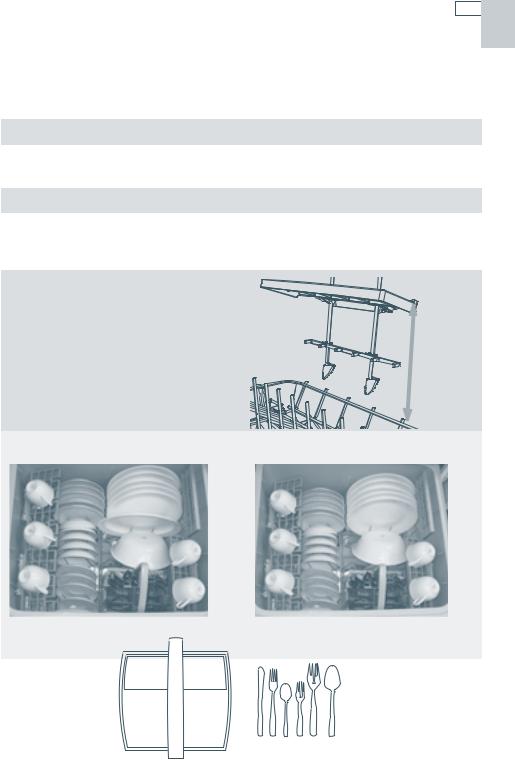
Dishwasher standards test 13 US CA
The DishDrawer®s are tested to various standards for both wash and dry performance.
The following are loading pattern diagrams, detergent quantities and rinse agent quantities used for the DishDrawer®.
Wash program
Detergent quantities
Rinse agent setting
Water softener setting
(for DD24-H models only)
Height setting of adjustable racks
Recommended loading pattern
Top drawer
|
3 |
|
6 |
1 |
1 |
5 |
|
3 |
|
|
|||
|
|
3 |
|
3 |
1 |
|
|
|
3 |
|
3 |
|
|
|
|
3 |
|
3 |
1 |
|
|
1 |
3 |
|
3 |
|
|
|
2 |
2 |
2 |
2 |
|
2 |
|
|
|||||
|
|
|
|
|
|
|
|
|
|
|
|
|
|
|
|
|
4 |
4 |
4 |
4 |
4 |
|
|
||||
Normal
5g (pre-wash) per drawer
10g (main wash) per drawer
4
Adjust the water softener to match the water hardness. Refer to the ‘Water softener’ and ‘Option adjustment’ section.
5½”
(140mm)
Bottom drawer
1 2 3 4 5 6

US CA 14 Racking features
Cutlery basket
Mix spoons, knives and forks within each section to stop cutlery nesting together.
Most cutlery is placed with the handle pointing down.
For your safety, knives and sharp utensils should have their handles up.
Small light items like baby bottle teats are best placed under the anti-nesting grids to prevent them from being displaced.
Stemware notches
The six notches on the lefthand side help support long-stemmed glassware.
Folding tines
The front half is ideal for large, deep bowls.
Fold the tine sections down towards each other if you need the space for pots or other large items.
Fold down the right-hand section only and lean cups against the upright tines for extra stability.
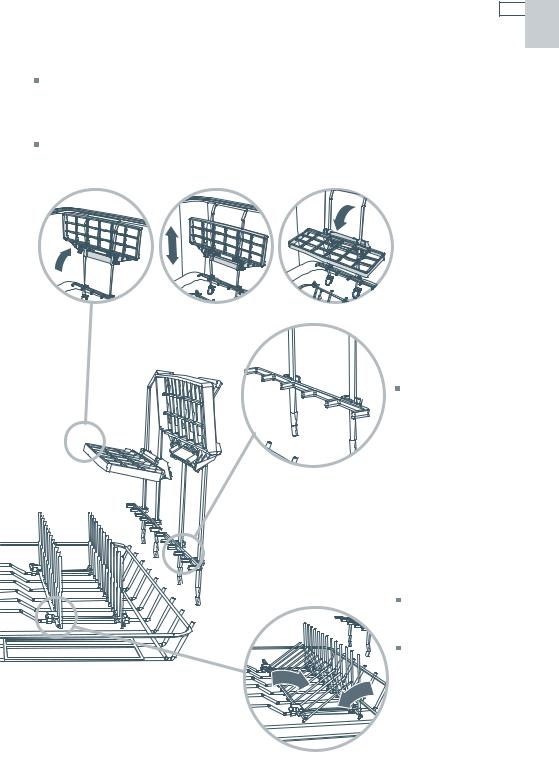
Racking features 15 US CA
Adjustable racks
You can adjust these independently of each other to any height:
1Fold up to unlock the rack.
2Adjust the height to suit by sliding up or down.
3Fold down to lock in position.
Fold the racks away if you need the space.
1 |
2 |
3 |
Glass supports
These clip on the rack wires to give your tall glasses extra stability.
‘Slide-and-fold’
tines
Slide all the way to the left to fit larger dinner plates.
Fold the tine sections down towards each other if you need the space for pots or other large items.
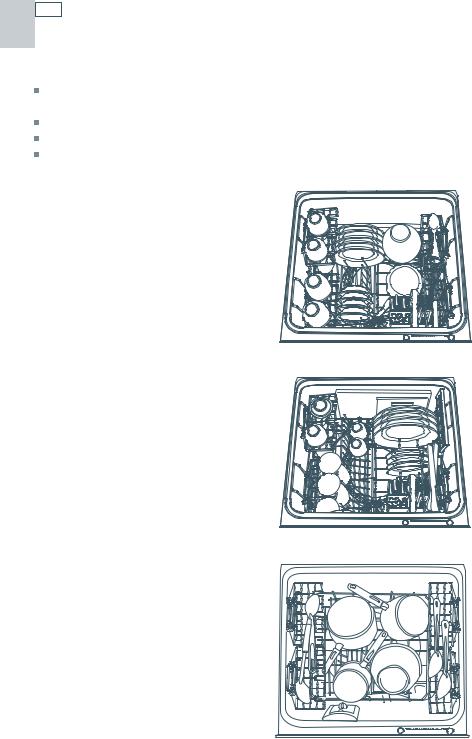
US CA 16 Loading suggestions
When loading your DishDrawer, make sure that
you place items so that water coming from the rotating spray arm below can reach all areas (performance will be reduced if it can’t)
nothing blocks the water from getting to items on the adjustable racks you place bowls and pots with their openings facing down
plates do not nest together.
Typical breakfast load
Typical dinner party load
Typical heavy load

Loading suggestions 17 US CA
How NOT to load your DishDrawer®
Overcrowded and wash water will not reach some of the dinnerware.
Cups, glasses and bowls must have their openings facing down.
Ensure dishware items are not forced into or protrude out of the drawer as it may prevent the lid from properly sealing which could result in a service call. Locate sharp items safely to prevent injuring the user and damaging the lid assembly.
Check the bottom of the cutlery basket to ensure sharp or pointed items have not come through as they may stop spray arm rotation.
The plates are nesting together and wash water may not get through.
Ensure cutlery are not nesting or stuck together. They need to be evenly spread out.
Ensure cutlery has not fallen through the base rack and stopped the spray arm from rotating.
The large bowl is blocking wash water reaching the adjustable racks.
Large utensils should be on the adjustable racks so they do not become dislodged and stop the spray arm from rotating.
Sharp or pointed items must be placed horizontally or with sharp edges/points facing down to avoid risk of injury.
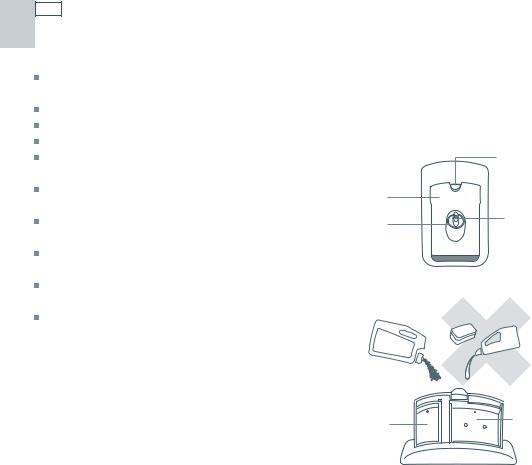
US CA 18 Detergent dispenser
Important!
Only use powdered detergent recommended for domestic automatic dishwashers in the detergent dispenser.
Dishwasher detergents are strongly alkaline and can be dangerous if swallowed. Avoid contact with skin and eyes.
Keep children and infirm persons away from the DishDrawer® when the drawer is open.
Check that the detergent receptacle is empty after completion |
c |
|
of the wash cycle. |
|
|
We do not recommend using dishwasher tablets |
a,b |
|
in the DishDrawer®. |
||
|
||
Do not place dishwasher tablets in the |
e |
|
detergent dispenser. |
|
|
Detergent and dishwasher tablets should not |
|
|
be in direct contact with dishes or cutlery. |
Closed detergent dispenser |
|
Liquid detergents are not suitable to be used in |
||
|
||
the DishDrawer®. |
|
|
Hand washing liquids, soap, laundry detergents |
|
|
or disinfectants will damage the DishDrawer®. |
|
Filling the detergent dispenser
1Press the latch down and the door will open.
2Pour in detergent. No detergent is needed for the Rinse program.
3After filling the main wash compartment, close the dispenser door until it clicks shut. The detergent will automatically be released into the DishDrawer® during the wash program.
a |
b |
|
Open detergent dispenser
aPre-wash compartment, 10g / 2 teaspoon capacity
bMain wash compartment, 30g / 6 teaspoon capacity
c Detergent dispenser latch d Rinse agent indicator light
eRinse agent plug

Detergent dispenser 19 US CA
Detergent quantities
The detergent quantities recommended below are for individual drawers.
Water type |
Wash program |
Detergent quantities |
|
parts per million (ppm) |
|
prewash |
main wash |
grains per gallon (gpg) |
|
(teaspoons) |
(teaspoons) |
Hard (>150ppm or >9gpg) |
All* |
2 |
6 |
Medium (100-150ppm or 6-9gpg) |
All* |
2 |
4 |
Soft (<100ppm or <6gpg) |
Heavy |
1 |
3 |
|
Normal |
1 |
2 |
|
Delicate |
|
1 |
|
Fast |
|
1 |
|
|
|
|
* No detergent is required in the pre wash compartment for the Fast wash program.
Hard water situations
If you live in a hard water situation, we recommend the installation of a household water softener to improve the water quality, detergent effectiveness and prevent the build-up of calcium deposits on dishes and in the DishDrawer®.
Certain brands of dishwasher detergent contain varying quantities of phosphates, which help soften water. We suggest you use a detergent with high phosphate
content to improve the wash. The detergent compartments need to be completely FULL and rinse agent is used with its setting fixed at 5.
We recommend the use of a dishwasher cleaner/descaler whenever you notice a build-up of calcium deposits in your DishDrawer®.
After you have used the dishwasher cleaner/descaler you must run another wash program with detergent to prevent damage to the DishDrawer®.
Soft water situations
If you live in an area of naturally soft water or your household water is softened, avoid using too much detergent in your
DishDrawer®. An excess amount of detergent is very aggressive on glassware and may cause irreversible etching.
Etching is a chemical deterioration that occurs on the surface of glassware when it is subjected to high temperatures, too
much detergent and/or soft water situations. Etching is caused by a combination of very hot water, which causes the detergent to become very aggressive, but because the water is soft, there are no water hardness mineral ions for the detergent to bind to,
so it extracts mineral ions directly from the glass.
Etching looks like rainbow-colored film, as the glass is subjected to further washing the surface will eventually appear opaque. This type of etching is irreversible.
To prevent further etching from occurring on glassware, use less detergent (follow the recommended detergent quantities in the user guide for soft water situations), and ensure the DishDrawer® is not overloaded, so water can reach all the dishes during the wash.

US CA 20 Water softener (DD24-H models only)
Setting up the water softener
Using hard water (above 100ppm) for dishwashing can be detrimental to the performance of your DishDrawer®. Glasses will become opaque and dishes will become spotted or covered in a white film.
Determine the water hardness in your local area
Your local water company will be able to provide you with information. Identify the setting you require for your DishDrawer® from the water hardness table below. For example, if your water hardness is 500ppm, then the water softener setting on your DishDrawer® should be four. Refer to the ‘Option adjustments’ section to adjust the water softener so that the setting corresponds to your water hardness.
DishDrawer® setting |
Grains per Gallon (gpg) |
Parts per Million (ppm) |
|
|
|
0 |
0-6 |
0-100 |
1 |
6-14 |
100-250 |
2 |
14-20 |
250-350 |
3 |
20-26 |
350-450 |
4 |
26-32 |
450-550 |
5 |
32-36 |
550-625 |
|
|
|
Note:
If your water hardness is above 625ppm, we highly recommend you completely fill the detergent compartment for all programs except Rinse and the rinse agent setting be at 5. If your water hardness is above 625ppm, the wash performance of your DishDrawer® will decline.
You may hear some unusual noises when the water softener is in operation, this is normal.
How to fill the salt reservoir
1Open the DishDrawer®.
2Unscrew the salt reservoir cap by turning counterclockwise.
3 Place the salt into the salt container and pour the contents into the salt reservoir. The salt reservoir can hold just over one pound/0.5 kg of salt.
4Fit the cap tightly back into its original position.
5If you do not wash your dishes immediately after filling the salt reservoir, run a Rinse program to remove any salt water or spilt granules.
Note:
When filling the salt reservoir, you may notice water being displaced from the water softener
overflow.
Salt reservoir
Salt container
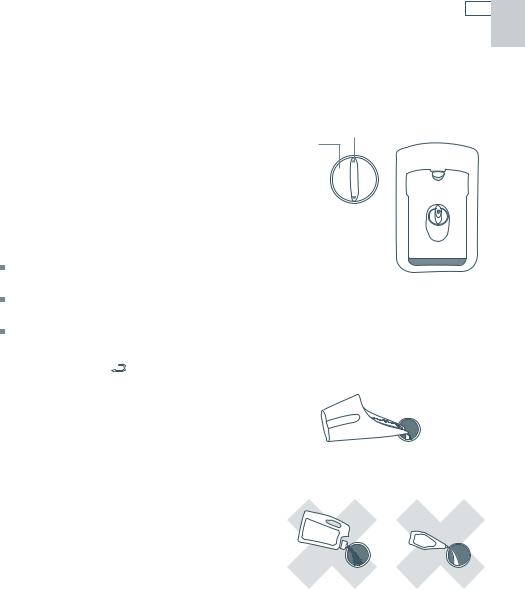
Water softener (DD24-H models only) 21 US CA
Important!
The water softener must always be filled with granular salt made especially for dishwasher water softening systems. We do not recommend the use of cooking salt like table salt, rock salt or pellets as they may contain impurities that will impair or diminish the life of the water softener.
The salt reservoir |
b |
Water softening can only take place when there is salt in the reservoir. The salt reservoir must be filled prior to using the DishDrawer® and whenever the salt reservoir indicator light is red.
Salt indicator light
If the salt indicator light is red, the salt reservoir is empty.
If the salt indicator light is black, there is enough salt in the reservoir for the wash program that has been selected. Models with LCD only: The electronic display will
also indicate when the salt reservoir is empty by displaying the salt  symbol.
symbol.
a
a Salt indicator light
bSalt reservoir cap
Important!
Do not pour detergent or rinse agent into the salt reservoir. Detergent and rinse agent will destroy
the water softener.
Salt only
NO Detergent |
NO Rinse Agent |
